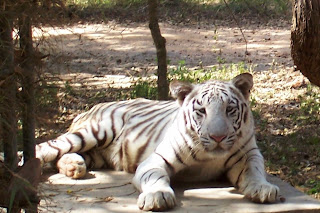Ganges River Dolphin
(Platanista gangetica )

The blind dolphin of River Ganges.
The Gangetic dolphin, declared one of the world’s first protected species more than 2,000 years ago, during the reign of Emperor Ashoka (265-232BC) is heading for extinction. Now fewer than 2000 individuals survive.
The Ganges River dolphin,also known susu for the sound made when they breathe at the wate’s surface, is a very strange-looking dolphin. The body is robust and soft, with a flexible neck, often characterized by a constriction or crease. The long beak is distinct from the steep forehead, but there is no crease between them. The beak is like a pair of forceps, is laterally compressed, and widens at the tip; it is proportionately longer in females than in males. The blowhole, unlike that of most cetaceans, is a slit that runs along the long axis of the animal's body. There is a shallow ridge on the melon, in front of the blowhole. The eyes are extremely small and are located above the distinctly upturned corners of the mouth. Although its eye lacks a lense(this species is also referred to as the “blind dolphin”, the dolphin still uses its eye to locate itself. The dorsal fin is a very low and wide-based triangle about two-thirds of the way to the flukes, which are concave along the rear margin. The broad flippers usually have a flat trailing edge, but it is sometimes scalloped.
Biology and Behaviour
As is true for most of the river dolphins, Ganges River dolphins generally live in small groups of less than 10 individuals, and are most often seen alone or in pairs. They are active animals, but they do not often engage in leaps. In captivity, these dolphins appear to spend much of their time swimming on their sides, and they constantly emit echolocation clicks.
The Ganges and Indus River Dolphins are essentially identical in appearance. They have the long, pointed noses characteristic of all river dolphins. The teeth are visible in both the upper and lower jaws even when the mouth is closed. The teeth of young animals are almost an inch long, thin and curved; however, as animals age the teeth undergo considerable changes and in mature adults become square, bony, flat disks. The snout thickens towards its end. Navigation and hunting are carried out using echolocation. The body is a brownish colour and stocky at the middle. The species has only a small triangular lump in the place of a dorsal fin. The flippers and tail are thin and large in relation to the body size, which is about 2-2.2 meters in males and 2.4-2.6 m in females. The oldest recorded animal was a 28 year old male 199 centimeters in length . Mature adult females are larger than males. Sexual dimorphism is expressed after females reach about 150 cm; the female rostrum continues to grow after the male rostrum stops growing, eventually reaching approximately 20 cm longer. Calves have been observed between January and May and do not appear to stay with the mother for more than a few months. Gestation is thought to be approximately 9-10 months.The species feeds on a variety of shrimp and fish, including carp and catfish. Dolphins are usually encountered on their own or in loose aggregations; they do not form tight, obviously interacting groups.
The Ganges and Indus River Dolphins are essentially identical in appearance. They have the long, pointed noses characteristic of all river dolphins. The teeth are visible in both the upper and lower jaws even when the mouth is closed. The teeth of young animals are almost an inch long, thin and curved; however, as animals age the teeth undergo considerable changes and in mature adults become square, bony, flat disks. The snout thickens towards its end. Navigation and hunting are carried out using echolocation. The body is a brownish colour and stocky at the middle. The species has only a small triangular lump in the place of a dorsal fin. The flippers and tail are thin and large in relation to the body size, which is about 2-2.2 meters in males and 2.4-2.6 m in females. The oldest recorded animal was a 28 year old male 199 centimeters in length . Mature adult females are larger than males. Sexual dimorphism is expressed after females reach about 150 cm; the female rostrum continues to grow after the male rostrum stops growing, eventually reaching approximately 20 cm longer. Calves have been observed between January and May and do not appear to stay with the mother for more than a few months. Gestation is thought to be approximately 9-10 months.The species feeds on a variety of shrimp and fish, including carp and catfish. Dolphins are usually encountered on their own or in loose aggregations; they do not form tight, obviously interacting groups.
Reference:Wikipedia














